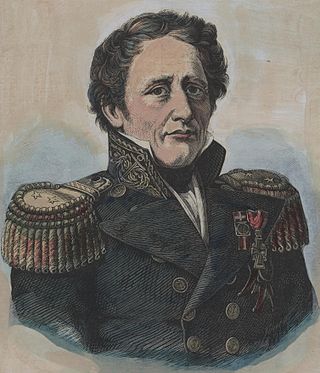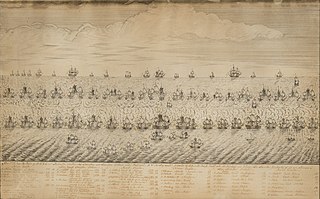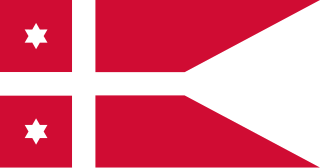Grand admiral is a historic naval rank, the highest rank in the several European navies that used it. It is best known for its use in Germany as Großadmiral. A comparable rank in modern navies is that of admiral of the fleet.

HDMS Najaden was a frigate of the Royal Dano-Norwegian Navy, which she served from 1796 until the British captured her in 1807. While in Dano-Norwegian service she participated in an action at Tripoli, North Africa. She served the Royal Navy as the fifth rate HMS Nyaden from 1808 until 1812 when she was broken up. During her brief British service she participated in some small attacks in the Barents Sea during the Anglo-Russian War.

Jens Schou Fabricius was the Norwegian appointed Minister of the Navy 1817–1818. He served as a representative for Søe-Deffensionen at the Norwegian Constitutional Assembly at Eidsvoll in 1814. During his naval career he served first the Danish Crown until the separation in 1814 of Norway from Denmark, and thereafter the Norwegian-Swedish Crown. Fabricius retired from the navy as a vice admiral.
The Admiral Danish Fleet (ADMDANFLT) was the operationally supreme organisation of the Royal Danish Navy between 1 January 1991 and 30 September 2014.

Frederik Christian Kaas was a Danish naval officer and landowner. He served as the governor of the Royal Danish Naval Academy from 1770 to 1781.
The name of Steen Andersen Bille is closely associated with one extended family of Danish naval officers over several generations.

Jochum Nicolay Müller was a Norwegian naval officer who, as a midshipman, excelled at mathematics. As a junior lieutenant he met Horatio Nelson, and as a captain commanded the Finnmark squadron. He finally rose to the rank of Vice Admiral in the independent Royal Norwegian Navy.

Battle of Rügen was a major naval battle fought on August 8, 1715 off Jasmund on the Swedish island of Rügen during the Great Northern War.

HDMS Elephanten was a ship of the line of the Royal Dano-Norwegian Navy that served from 1703 to 1728. There were three other Danish ships-of-the line of the same name, dating from 1684, 1741 and 1773. The ship was sometimes referred to as Nye Elefant to differentiate from others of similar name. For much of her service career, which coincided with the Great Northern War, Elephanten was the flagship of the Danish fleet active in the Baltic Sea.

The Secretary of War was from 1688 the administrative leader of the military in Denmark-Norway. In 1736, it was divided into separate offices for the Army and the Navy and was dissolved as part of Johann Friedrich Struensee's administrative reforms in 1770.

The Chief of the Royal Danish Navy is the professional head of the Royal Danish Navy.

Christian Wulff was a Danish naval officer. He commanded HDMS Bellona on her expedition to South America in 1840–41.
Admiral of the Realm was a military and political title given to nobles in Denmark-Norway, Sweden and Holy Roman Empire.

Ernst Wilhelm Stibolt was a Danish naval officer and ship builder, who served in the French navy for four years. and became a member of the Royal Danish Academy of Sciences and Letters.
The family name Stibolt was closely associated with the Danish-Norwegian navy of the 18th century and with the island of Christiansø from the time that Hans Anderson Stibolt was appointed commandant of those most easterly islands of Denmark. His three sons all held naval officer rank, as did many of the subsequent generations, serving with a varied amount of success. Three generations held the post of Commandant on Christiansø.

The Naval Blockade of Reval was a blockade of the Russian fleet in the harbour of Reval in the summer of 1726 by a joint force of British and Danish ships.

HDMS Justitia was a ship-of-the-line designed by Ole Judichaer built at Nyholm, Copenhagen for the Royal Danish-Norwegian Navy.

Edouard Suenson was a Danish vice admiral known for his participation in the First and Second Schleswig War, and served as the main Danish commander at the Battle of Heligoland in the latter.























